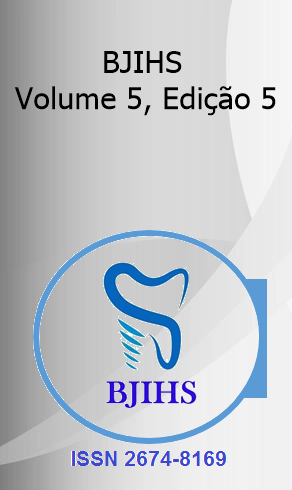Abstract
The article addresses mandibular fractures, which are common today, often resulting from traffic accidents, violence and falls. Surgical management is crucial to avoid future complications. The work describes a specific case in which Nylon tape (clip) was used to reduce a mandibular fracture in a male patient who was a victim of physical aggression. The patient, a homeless individual involved with narcotic substances, was treated by neurosurgery and trauma surgery teams. The fracture was initially reduced with nylon tape during primary care. The patient was subsequently transferred to the oral and maxillofacial surgery (BMF) team for definitive treatment. The treatment involved several steps, including nasotracheal intubation, antisepsis, local anesthesia, submandibular surgical access, removal of nylon tape, tooth extraction, cleaning of the fracture, manual reduction, plate fixation and occlusion review. The patient received conventional clinical support and was released on the second postoperative day for outpatient follow-up. The choice of fixation with replaced load of the 2.4 mm system (load bearing) stands out due to the need for high rigidity in contaminated fractures. The extraction of teeth 43 and 44 was carried out to avoid risks of contamination. The article concludes by highlighting the effectiveness and accessibility of using nylon tape for the temporary stabilization of mandibular fractures, providing local pain relief and reducing the distress associated with bone movement.
References
Serebrakian A, Maricevich R, Pickrell B. Mandible Fractures. Seminars in Plastic Surgery. 2017 May 9;31(02):100–7.
Chrcanovic BR, Abreu MHNG, Freire-Maia B, Souza LN. 1,454 mandibular fractures: A 3-year study in a hospital in Belo Horizonte, Brazil. Journal of Cranio-Maxillofacial Surgery. 2012 Feb;40(2):116–23.
Ogoshi JLP, Berardi RH, Zangrando D, Horikawa F kendi, Morimoto S, Shinohara EH. New method for intraoperatory occlusal restauration in mandibular angle fractures treatment using two modified reduction forcepssing two modified reduction forceps. ARCHIVES OF HEALTH INVESTIGATION. 2020 Aug 20;9(1).
Johnson AW. Dental occlusion ties: A rapid, safe, and non-invasive maxillo-mandibular fixation technology. Laryngoscope Investigative Otolaryngology. 2017 Apr 12;2(4):178–83.
Engelstad ME, Kelly P. Embrasure Wires for Intraoperative Maxillomandibular Fixation Are Rapid and Effective. Journal of Oral and Maxillofacial Surgery. 2011 Jan;69(1):120–4.
Aditya Narayan Choudhary, Kumar S. Cable Ties: Poor Man’s Top Closure System. Indian Journal of Plastic Surgery [Internet]. 2023 Apr 1 [cited 2023 Nov 16];56(02):182–4. Available from: https://www.ncbi.nlm.nih.gov/pmc/articles/PMC10159720/
Partridge A. NYLON STRAPS FOR INTERNAL FIXATION OF BONE. The Lancet. 1976 Dec;308(7997):1252.
McEwan TW, Muzaffar AR. Principles of Internal Fixation of the Craniomaxillofacial Skeleton. Plastic and Reconstructive Surgery. 2014 Oct;134(4):856–7.

This work is licensed under a Creative Commons Attribution 4.0 International License.
Copyright (c) 2023 Bianca Gomes Teixeira, Eliseu Gabriel Faustino, Denis Zangrando, Fernando Kendi Horikawa, Elio Hitoshi Shinohara, Julliana Cariry Palhano Freire, Lucas Emmanuel de Morais Neves, Eduardo Sant'Ana, Marcos Antônio Farias de Paiva, Eduardo Dias Ribeiro
